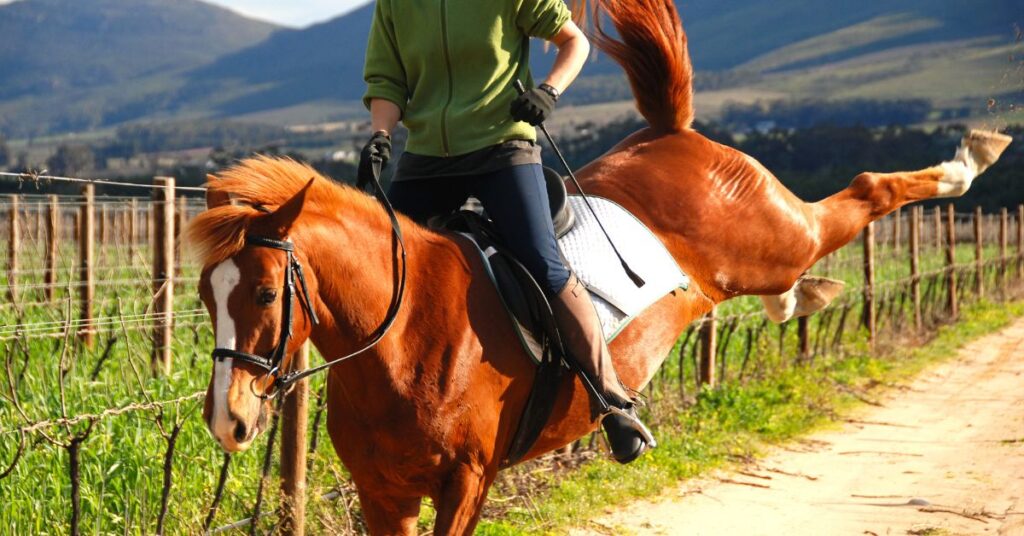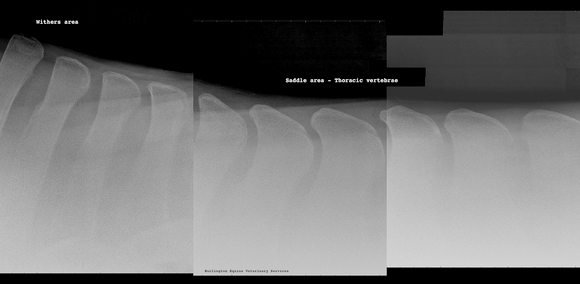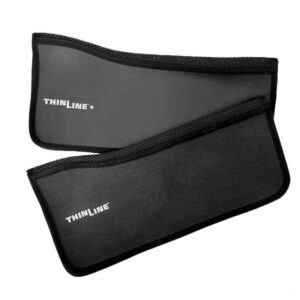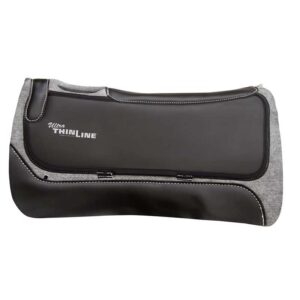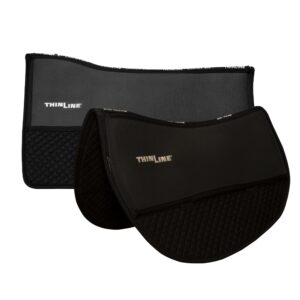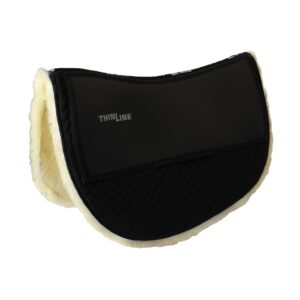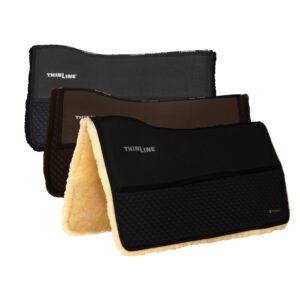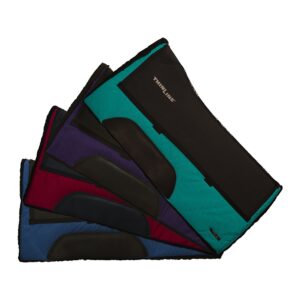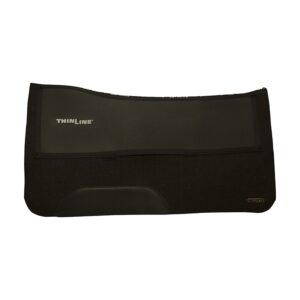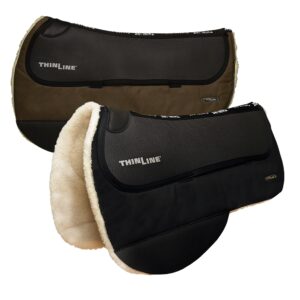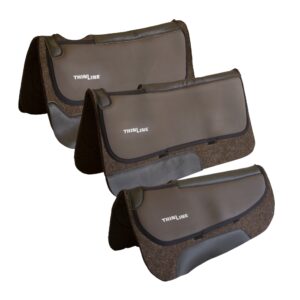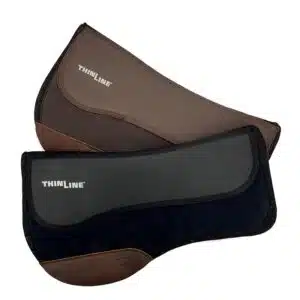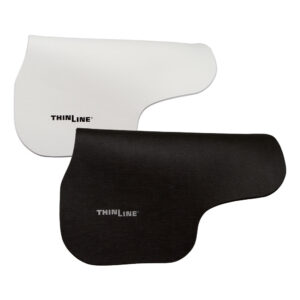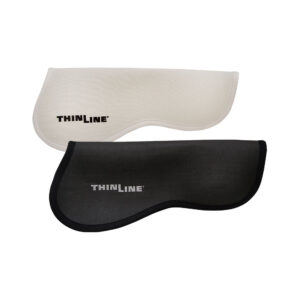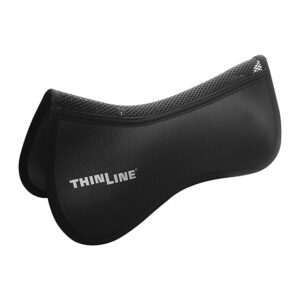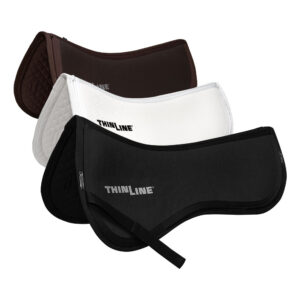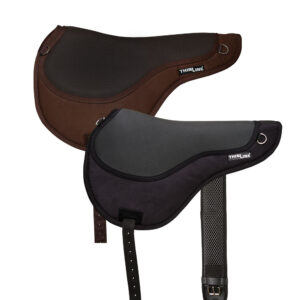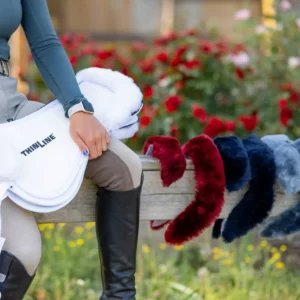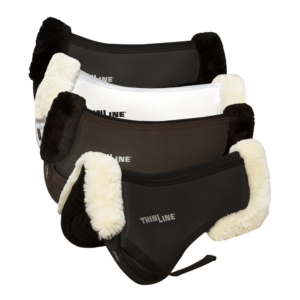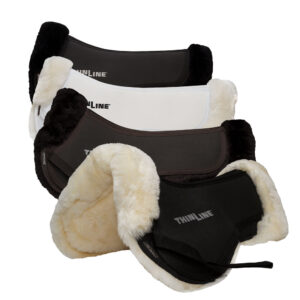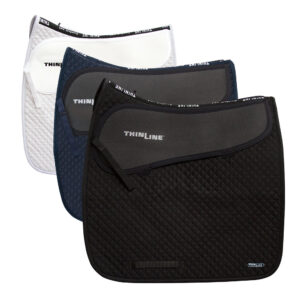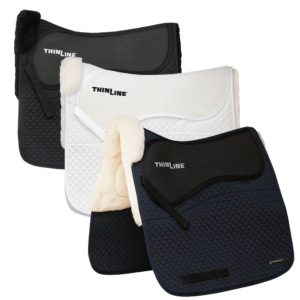Kissing Spine Symptoms, how to detect?
Kissing Spine Symptoms are often overlooked, under-treated and misunderstood. These are frequently mistaken with bad behaviour.
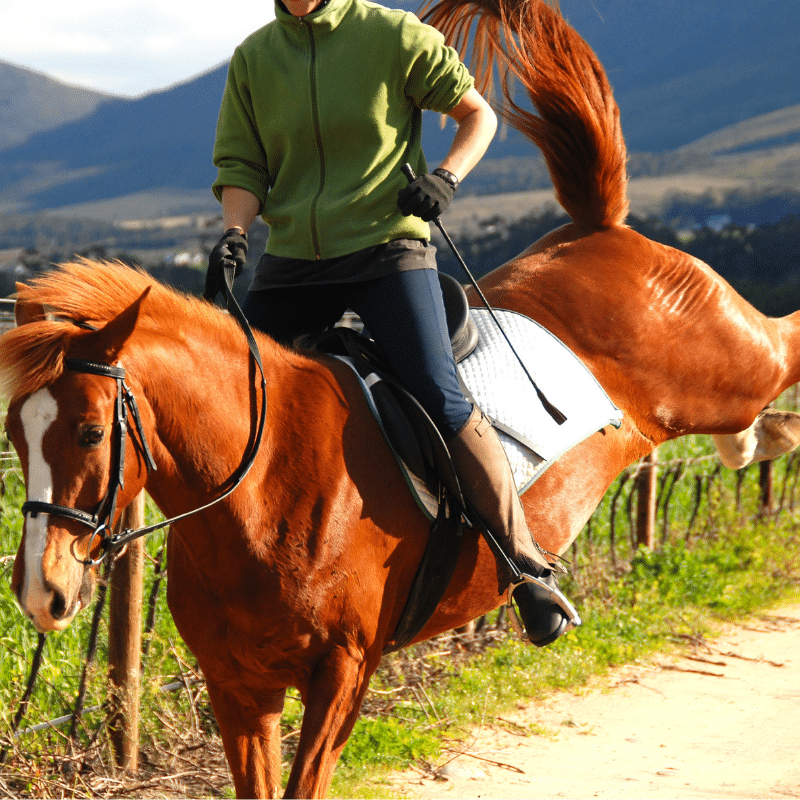
Detecting Kissing Spine Symptoms comes in 2 forms:
-
- Behavioural Kissing Spine Symptoms (which you might find yourself)
- Clinical Kissing Spine Symptoms and Detection
Behavioural Kissing Spine Symptoms?
Horses with this condition can exhibit a range of signs from being asymptomatic, that is exhibiting no abnormal signs, up to having a horse that is unrideable, possibly bucking, refusing to be saddled and/or having behavioural issues even on the ground.
-
- Signs of discomfort like shifting weight, biting, bucking
- Showing discomfort when putting the saddle on or girthing up
- Difficulties to change paces (often in canter)
- Changes in temperament
- Difficulties to mount
- Possible loss of muscle mass in the top line
It is important to note that some horses with Kissing Spine Symptoms diagnosed on X-ray don’t show discomfort or signs of above.
The question isn’t understanding the more obviously affected horse; instead, it’s the asymptomatic horses. The radiographic changes didn’t occur overnight and there are certainly horses that have been in regular work during this time and able to do jump, be used for dressage and/or western pleasure while the radiographs would have looked abnormal.
Clinical Kissing Spine Symptoms and Detection?
Radiographs
Diagnosing Kissing Spine in horses can be a straightforward process in some cases; in others, it’s a process of elimination. The history and clinical signs are particularly beneficial to the Veterinarian. Following this Radiographs are the first line of defense. Digital x-rays allow us to take radiographs of a horse’s back in a matter of minutes and clearly see if there are issues present as seen in the image below:
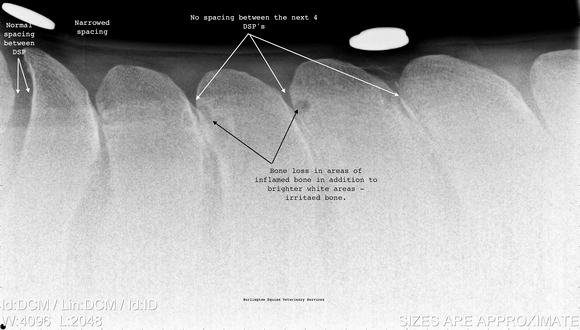
Ultrasound
Ultrasound is also sometimes employed. When considering Kissing Spine Symptoms, traditionally it’s been considered a great modality to evaluate soft tissues, but it’s exceptionally helpful when looking at bone surfaces. While X-rays penetrate bone and show the margins and inside of bones, ultrasound shows a significant amount of detail about the bone surface and soft tissues attached to them. What can’t be appreciated in some circumstances without ultrasound is back soreness from the ligament that runs over the spine and inserts into these DSP’s nor the ligaments that are located between the bones?
Thermography
Thermography is also used by me in cases where I want to evaluate heat output which can correlate to inflammation. When suspecting Kissing Spine Symptoms, by using a thermal camera you can visualise areas of the back, legs, and even saddle fit. The more intensely red or white areas correlate with inflammation.The following two pictures demonstrate a more normal back on the left compared to the one on the right with more inflammation in the saddle (thoracic) area as well as over the hips (sacroiliac) areas.
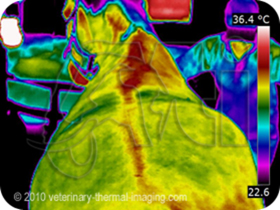
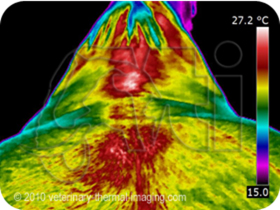
Nuclear Scan
In cases where there are more questions as to the involvement of the back versus other areas, a Nuclear Scan can be done. These are procedures done at referral hospitals. The advantage is that, like thermography, they are dynamic exams and show problems in real time as opposed to static exams such as radiographs or ultrasound that show what is currently there, but don’t necessarily correlate to inflammation.
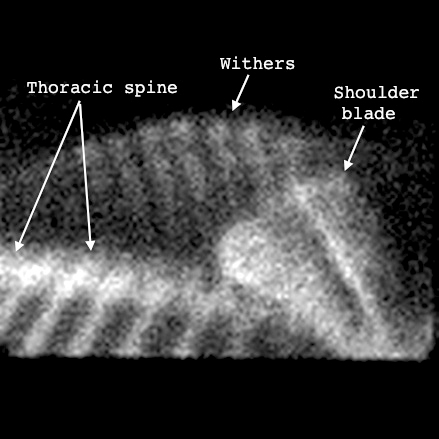
How to treat Kissing Spine Symptoms?
My horse is behaving badly and I cannot figure out why. I am afraid the veterinarian will say it is kissing spine disease, and I do not want to think about surgery. What can I do?
Also here there are 2 ways for treatment:
-
- Individually & Preventing Kissing Spine Symptoms
- Veterinary Treatment for Kissing Spine Disease
Sometimes just a tack change can successfully head off major veterinary bills.
Whether the culprit is saddle fit, less than perfect training, or less than perfect riding we know for certain; the comfort of the horses back needs to be addressed as quickly and as simply as possible. Both pre and post surgical horses find relief in ThinLine’s therapeutic saddle pads.
Individually & Preventing Kissing Spine Symptoms
If you are beginning to suspect your horses’ unhappiness may be associated with pain, and generally speaking it is, we have set forth the easiest methods for you to check off your list before entertaining more aggressive treatments.
- Alternative modalities
- Training and Physical Therapy
- Tack changes can head of major veterinary bills.
- Saddle Fitting Solutions
- Equine Rehabilitation and Schooling
Learn more about these different methods in our article we wrote and how you can evaluate yourself on the button below.
Veterinary Treatment for Kissing Spine Disease
As might be expected treatments can vary. The most important concept is that regardless of the treatment, physical therapy is even more integral to a successful outcome. What I am referring to here is that the treatments can help manage the soreness short term and even for longer periods, but without instituting a modification in the riding, training and/or tack the problem may continue to affect the horse.
Injections
Generally, I have found that treatment of the affected areas with injections using a combination of corticosteroids and Sarapin has been beneficial. In most cases that will be my first treatment and often done at the same time, the radiographs are taken if the diagnosis is definitive.
Shockwave Therapy (SWT)
Over the years I have treated numerous horses with Shockwave Therapy (SWT) and have also found this effective; in fact, for some horses, the benefits are about the same as injections. SWT is also beneficial as a management tool, that is allowing treatment periodically and/or a short time before competitions may decrease the discomfort associated with this chronic condition.
Laser treatments
In some of the acute conditions, I have effectively used a laser to treat focal areas of inflammation. Laser treatments can treat inflammation of the bone, soft tissues, and nerves.
Tildren
Tildren is the newest medication that I would add to my list. Most of the research with this drug has been done in Europe and it has proven benefits for horses with kissing spine Symptoms. The essential mechanism is that it decreases the bone destructive process of bone inflammation and “turns on” the bone cells that help to rebuild damaged bone.
What is unique with this medication is that its role is not to mask pain, but to improve damaged bone which interrupts the destructive process and improves long-term comfort. Currently, I import it from France with a special permit and have used it successfully in numerous cases. While it is somewhat costly, the benefits far outweigh any negatives.
The horse below with kissing spines that were unwilling to go forward comfortably refused jumps and would not collect well was treated with Tildren. Following treatment, he was markedly improved and the results lasted longer than when just local injections were used.
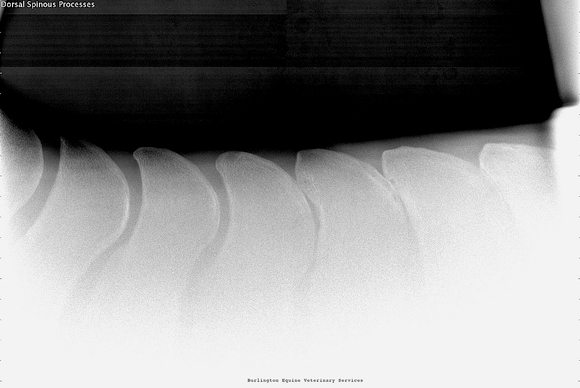
Veterinarians endorse ThinLine for Equine Spinal Problems.
More information about Kissing Spine Symptoms from a top Veterinarian!

Dorsal Spinous Process (DSP) impingement or “Kissing Spines” is a condition recognised as a significant issue for horses. What constitutes the problem is debatable and how to make a conclusive diagnosis can be an elusive process.
The Vertebrae
In order to understand the issues behind DSP impingement, you have to understand a few anatomical factors. Generally, the problem is located in the thoracic section of the vertebral column – the area where the rider sits. Less commonly, the involvement of the lumbar vertebrae behind the saddle area can be the source of the problem.
As you can see the attached picture, the thoracic vertebrae begin with the withers and go through the saddle area.
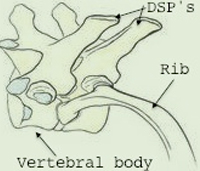
The part of the vertebrae that we are interested in is the vertical part that projects up and should be evenly spaced from the adjacent process. In the following picture, two dorsal spinous processes are seen with the correct relationship.
In order to understand the correct relationship between the vertebrae in the back, a radiograph is the easiest way to see how the bones sit relative to one another. The following picture is of a combined back radiograph from a horse with normal spacing.
The left side of the image starts with the withers and moves down the back to the right showing the lower back. The tall vertical DSP’s that make up the withers are narrow and long but are usually not involved with Kissing Spine Disease; instead, it’s usually the group of vertebrae behind this area – the thoracic vertebrae, in the area where the rider sits. As you can see the spacing between the DSP’s is even and there is no significant bone reaction.
The Radiographs
The next picture is of an abnormal radiograph which clearly depicts kissing spines. As you can see the finger like spinous processes are either touching the adjacent process and in some cases actually overlapping.
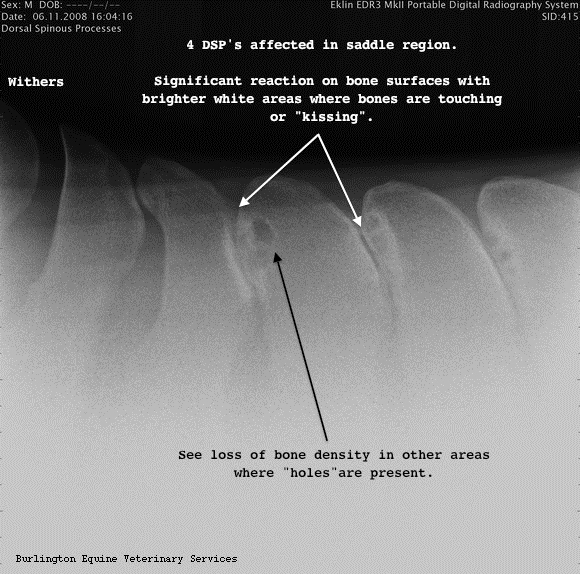
Clinical Signs of Kissing Spine Disease
Horses with this condition can exhibit a range of signs from being asymptomatic, that is exhibiting no abnormal signs, up to having a horse that is unrideable, possibly bucking, refusing to be saddled and/or having behavioural issues even on the ground. The question isn’t understanding the more obviously affected horse; instead, it’s the asymptomatic horses.
The radiographic changes didn’t occur overnight and there are certainly horses that have been in regular work during this time and able to do jump, be used for dressage and/or western pleasure while the radiographs would have looked abnormal. Something must change in order for the problem to be evident and something must change again if the problem is going to get under control.
I have heard a variety of complaints from the riders and trainers over the years associated with this condition, the most common one relates to behaviour-training issues. Generally, the horses may not be overtly lame, but rather exhibiting avoidance behaviours that affect their work such as: refusing to accept bit contact.
Preferring to travel with their heads up and their backs dropped (not rounded), unwilling to bend one direction or the other, not consistently picking up the correct lead, feeling disconnected or possibly cross cantering. Obviously, these signs could be associated with a number of issues for example stomach ulcers, Lyme disease, tack, training, rider to name a few.
ThinLine works with veterinarians to improve equine comfort and recovery from spinal issues including kissing spine.
Content © Burlington Equine Veterinary Services, LLC





